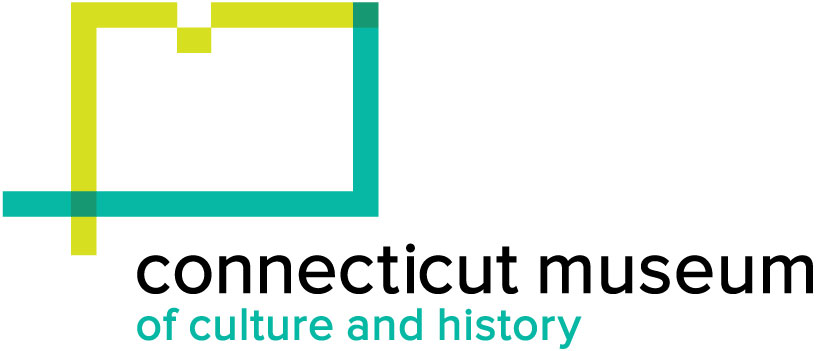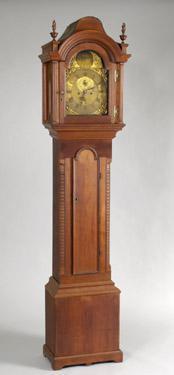Tall Case Clock
ClockmakerWorks probably made by
John Avery Jr.
(American, 1732 - 1794)
ClockmakerWorks possibly made by
Captain John Avery Sr.
(American)
Furniture MakerCase made by
Unknown
Dateabout 1770
MediumCase: Cherry primary wood, chestnut secondary wood.
Dial: Brass.
Works: Brass.
DimensionsPrimary Dimensions (height x width x depth): 83 1/2 x 16 1/4 x 9 9/16in. (212.1 x 41.3 x 24.3cm)
ClassificationsClocks
Credit LineBequest of Margaret B. Zacher
Object number2003.131.0
DescriptionTall case clock in the Chippendale, or rococo, style, with a cherry case, a pagoda pediment at the top of the hood, a brass clock movement, and a brass dial that is engraved "John Avery/ PRESTON". The tall case clock consists of three major components: the removable hood, the removable dial and clock works, and the clock case. The dial and works sit on a horizontal board at the top of the clock case; the pendulum (missing) and weights that drive the works would be suspended in the trunk, or narrow body, of the case. The hood slides over the works and sits at the top of the case.
At the top of the hood are three wooden finials (replaced), each consisting of a slender cone atop a ball. The top of the pediment is flat in the center and slopes down at either side to meet the top front corners of the hood; the pediment has a conforming roof, or bonnet top. The front of the hood has a square door with thumbnail, or ovolo, molding at all four sides. The door has a round glass window. The trunk of the clock case has deep cove, or recessed quarter-circle, molding at the top and bottom. The front of the trunk has a tall rectangular door with thumbnail molding on all four sides. Each front corner of the trunk is chamfered, with curved and tapered top and bottom terminals. The rectangular base of the clock case has cyma, or S-curved, base molding at the bottom front and sides.
Construction Details: A single vertically-oriented backboard with square top corners extends the full height of the hood and trunk; a separate horizontally oriented backboard is located across the back of the base. The hood does not have a back; it slides over the clock works to rest on the cove molding at the top of the trunk. The hood is constructed of a three-part frame: a pagoda-shaped pediment and two sides. The pediment is constructed of two vertical panels of wood that are joined to the upper front and back edges of each side of the hood. The bonnet top, or conforming roof, is nailed to the top edges of these two panels. The sides of the hood attach to a horizontal, three-sided frame with molding at the lower outside edges. The door is constructed of a four-sided frame that is tenoned and pinned together. The door pivots on a pair of brass hinges at the top right and bottom right corner; the door is held closed with a brass latch at the left side.
The backboard is nailed into a rabbet on each back corner of the sides of the trunk. The boards that form the sides of the trunk extend several inches above the bottom of the hood. The clock works rest on a seat board, or horizontal board immediately behind the dial. The seat board rests on the top edge of the sides of the trunk. The cove molding is nailed to the front and sides of the top and bottom of the trunk. The front of the trunk is constructed of a four-sided frame that is tenoned and pinned at each corner. The door is constructed of a single board that is joined to the trunk with two brass hinges at the right side; there is a keyhole and lock in the center left side. The sides of the trunk extend down to the top of the base. The front and sides of the base are each joined with a nailed butt joint at the front corners. The bottom board is covetailed to the underside of the base. The base molding is nailed to the front and sides of the base.
Dial: The engraved brass dial is round; it would have been silvered originally. The dial plate is engraved with a chapter ring, consisting of a ring of minute gradations, inside a ring of Arabic numbers from five to sixty in increments of five. In the center of the chapter ring is an arbor, or axle, around which a minute hand pivots. A round seconds dial is engraved above the main arbor, with a hand pivoting around the center. A round hour dial is engraved below the main arbor, with a hand pivoting around the center. The clockmaker's name, "John Avery", is engraved around the main arbor. The place name, "PRESTON", is engraved below the hour dial. A winding arbor is located to the lower right of the main arbor. Additional scroll and floral designs are engraved in the center of the dial plate.
Clock Works
Movement: weight powered
Duration: eight day
Materials: wood, brass
Strike: drop off
Escapement: recoil
This clock was a shop regulator; it would have been used to set the time on new clocks made in the Avery shop. The works have an astronomical dial; the minute hand is independent of the dial that runs the hour. The works are accompanied by a single cylindrical weight.
Condition: The case is refinished; the finails are replaced. The interior of the hood is lined with red felt. The silver has worn off the dial. The pendulum is missing; the one large, cylindrical weight is separated from the clock works. The clock case is accompanied by a key that does not work in the door lock.
At the top of the hood are three wooden finials (replaced), each consisting of a slender cone atop a ball. The top of the pediment is flat in the center and slopes down at either side to meet the top front corners of the hood; the pediment has a conforming roof, or bonnet top. The front of the hood has a square door with thumbnail, or ovolo, molding at all four sides. The door has a round glass window. The trunk of the clock case has deep cove, or recessed quarter-circle, molding at the top and bottom. The front of the trunk has a tall rectangular door with thumbnail molding on all four sides. Each front corner of the trunk is chamfered, with curved and tapered top and bottom terminals. The rectangular base of the clock case has cyma, or S-curved, base molding at the bottom front and sides.
Construction Details: A single vertically-oriented backboard with square top corners extends the full height of the hood and trunk; a separate horizontally oriented backboard is located across the back of the base. The hood does not have a back; it slides over the clock works to rest on the cove molding at the top of the trunk. The hood is constructed of a three-part frame: a pagoda-shaped pediment and two sides. The pediment is constructed of two vertical panels of wood that are joined to the upper front and back edges of each side of the hood. The bonnet top, or conforming roof, is nailed to the top edges of these two panels. The sides of the hood attach to a horizontal, three-sided frame with molding at the lower outside edges. The door is constructed of a four-sided frame that is tenoned and pinned together. The door pivots on a pair of brass hinges at the top right and bottom right corner; the door is held closed with a brass latch at the left side.
The backboard is nailed into a rabbet on each back corner of the sides of the trunk. The boards that form the sides of the trunk extend several inches above the bottom of the hood. The clock works rest on a seat board, or horizontal board immediately behind the dial. The seat board rests on the top edge of the sides of the trunk. The cove molding is nailed to the front and sides of the top and bottom of the trunk. The front of the trunk is constructed of a four-sided frame that is tenoned and pinned at each corner. The door is constructed of a single board that is joined to the trunk with two brass hinges at the right side; there is a keyhole and lock in the center left side. The sides of the trunk extend down to the top of the base. The front and sides of the base are each joined with a nailed butt joint at the front corners. The bottom board is covetailed to the underside of the base. The base molding is nailed to the front and sides of the base.
Dial: The engraved brass dial is round; it would have been silvered originally. The dial plate is engraved with a chapter ring, consisting of a ring of minute gradations, inside a ring of Arabic numbers from five to sixty in increments of five. In the center of the chapter ring is an arbor, or axle, around which a minute hand pivots. A round seconds dial is engraved above the main arbor, with a hand pivoting around the center. A round hour dial is engraved below the main arbor, with a hand pivoting around the center. The clockmaker's name, "John Avery", is engraved around the main arbor. The place name, "PRESTON", is engraved below the hour dial. A winding arbor is located to the lower right of the main arbor. Additional scroll and floral designs are engraved in the center of the dial plate.
Clock Works
Movement: weight powered
Duration: eight day
Materials: wood, brass
Strike: drop off
Escapement: recoil
This clock was a shop regulator; it would have been used to set the time on new clocks made in the Avery shop. The works have an astronomical dial; the minute hand is independent of the dial that runs the hour. The works are accompanied by a single cylindrical weight.
Condition: The case is refinished; the finails are replaced. The interior of the hood is lined with red felt. The silver has worn off the dial. The pendulum is missing; the one large, cylindrical weight is separated from the clock works. The clock case is accompanied by a key that does not work in the door lock.
Status
Not on view









